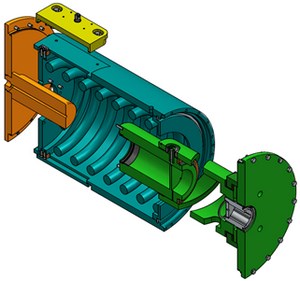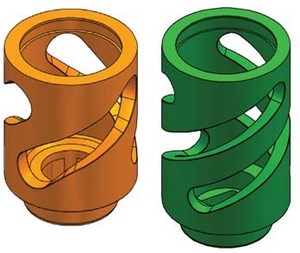Even though project demand in the oil and gas industry remains low, there is still a considerable demand for service and solutions based on quick response times This was the background that prompted Duxvalves to develop its new pneumatic and hydraulic actuator ranges – the Duxdrive – for choke and control applications (see Figures 1 and 2). In designing these valves, the company has also taken into consideration feedback from customers who increasingly prefer local manufacturing, whereby issues such as materials quality can be more closely monitored.
The design team have come up with a simple design with a minimized number of parts to achieve a high level of reliability. This is important to reduce the need for maintenance and thus saving costs during lifetime.The heart of the actuator is the curvesleeve where rollers run into curved slots and the linear movement of the hydraulic or pneumatic cylinder is converted into an output rotation (see Figures 3 and 4). The shape of the torque curve enables a desired torque characteristic to be made (see Figure 5). The type of torque characteristic depends on the application.
For modulating valves, it is important to have a smooth-running actuator which could be achieved by a linear curve. The half turn actuator is therefore equipped with this type of curve. For most other applications (e.g. ball valve, butterfly valve) a high breaking and ending torque is important. A curve with a steep beginning and end is therefore recommended for a more efficient torque characteristic. The quarter-turn model is equipped with a curve-sleeve according to this principle. Torque efficiency is essential to keep the actuator as compact as possible. For applications where a special torque curve is required, the curve-sleeve could also be custom made.
The actuator is built using different modules which helps maximise flexibility when it comes to sizing. The spring and cylinder module are available in a range of two or three sizes. Variations in cylinder size and spring force are required to cope with different operating pressures. The drive module is the base of the actuator, with most parts of the hydraulic variant exchangeable with the pneumatic one. The hydraulic actuator only has one pressurized seal resulting in minimum leakage chances. This rod seal seals the piston rod which is placed inside of the cylinder chamfer. Maintenance is easy as only the top cover with piston rod need to be removed to access and replace the rod seal (see Figure 6).
Another example of the simple design is the absence of adjustable travel stops inside the actuator. Again, the design team made this decision knowing that such parts often prove to be vulnerable due to high (dynamic) loads combined with a small built-in space. They chose instead an optional adjustment flange. This flange is optional because not all valves require a large adjustment of the open/close position.
In the case of the Duxvalve chokes, only slightly oversized valve mounting holes are required for accurate positioning. An adjustment flange is normally only necessary if a large overtravel and undertravel is required (up to +5° / -5°). But for modulating purposes the adjustment flange could also be customized with a larger undertravel (up to -20°). With this angle the opening orifice of a control valve could be changed and thus the flow regulated.
The design team have also paid considerable attention to materials selection, in order to balance the need for a robust actuator which can withstand harsh environments yet at the same time delivers a cost-efficient solution. For example, the standard option for the housing is carbon steel, which can be coated or painted as required. However, the stem adapter – the key component of the valve interface – has been made of a high grade stainless steel, reflecting the need for this component to be both strong and also corrosion-resistant in say offshore applications.
Similarly, the cylinder of the pneumatic actuator has a Xylan coating for ultimate corrosion and wear protection (see Figure 7). As the O-ring of the piston slides against the cylinder surface, both the cylinder and O-ring are subject to wear. Due to the coating the life of these parts is increased and possible corrosive effects of the medium are prevented. The corrosion resistance of this coating system has proven to be optimal according to ASTM B-117 salt fog testing. Xylan coated panels of zinc phosphate steel withstood 500 hours during the test.
Another reason for choosing Xylan coating above other protective coatings or treatments is the low friction coefficient due to the polymer compounds. Because of the low friction the piston is able to move slipstick free inside of the cylinder. A smoothrunning output is the result, crucial for accurate positioning of modulating valves.
Further features incorporated by the team into the final product include: Optional dual position indication: A position indication is indispensable for an actuator in order to visualize the rotational output or generate a feedback for positioning. For this purpose, a position indicator, limit switch or positioner needs to be connected. The indication used for the actuator is standardized according to VDI/VDE 3845 and located at the side of the actuator. Because some applications require a separate limit switch in addition to a positioner, an optional dual indication connection is also available(see Figure 8)
Direct mounting: The actuator- valve interface could be made custom so that direct mounting is possible. Most valves have an ISO 5211 connection (e.g. F10, F12, F16) but also special flange sizes could be mounted. This flexibility is important because direct mounting disables the need for mounting kits, making assembling faster and easier. Short assembly times are essential for oil and gas rigs. Production would only be possible after the actuator is installed and the system has been tested. Fasting up this process saves costs. Another benefit of direct mounting is a more compact building. Up to four different mounting positions are possible, so that hydraulic / pneumatic connections or control panels could be oriented as desired.
Spring return: The actuator is available either as spring return or as double acting model. The first variant has a spring module with a loaded spring inside. Chosen is for a design where the spring – clamped between flanges – is safely secured in the container. In this way the spring can never come free in an uncontrolled manner, even when disassembling the container from the rest of the actuator. As a result, unsafe situations during maintenance are prevented. During operation the upper flange is stopped at the end of the spring stroke by an edge inside of the cylinder (end stop). The lower flange is safely secured with a spring ring, inaccessible for dismounting
About the author
Mettinus Grimmerink is a project engineer for Duxvalves, located in Almelo, The Netherlands. Duxvalves is specialized in valve & actuator engineering, a company who manufactures not only hydraulic and pneumatic actuators, but also a wide range of choke and control valves. Working closely together with the production team, Mettinus has designed and developed the Duxdrive. In addition to actuation projects he is also involved with the production of valves.









